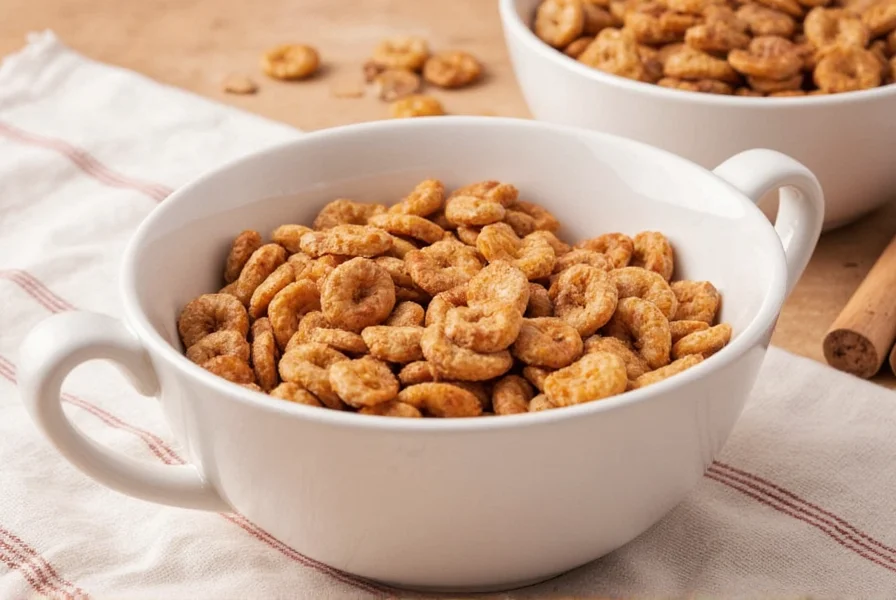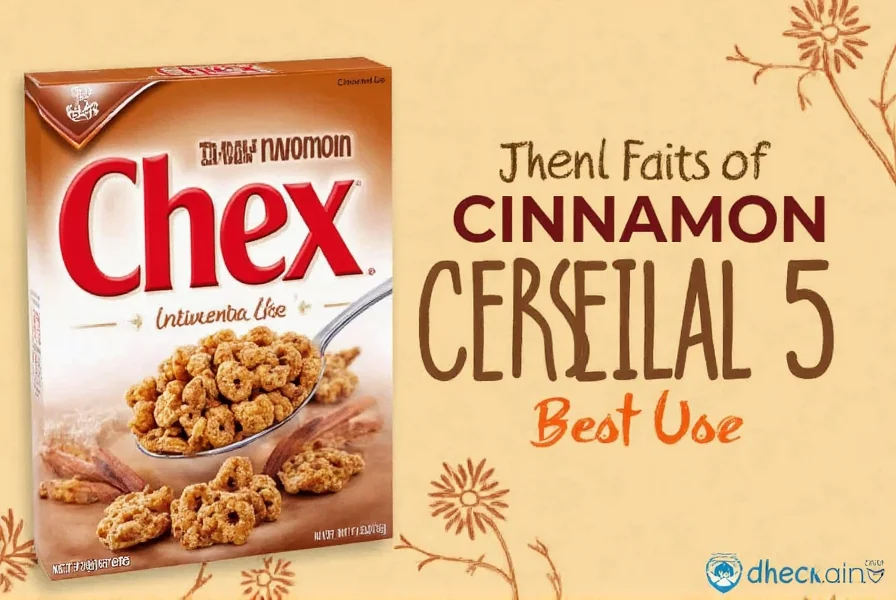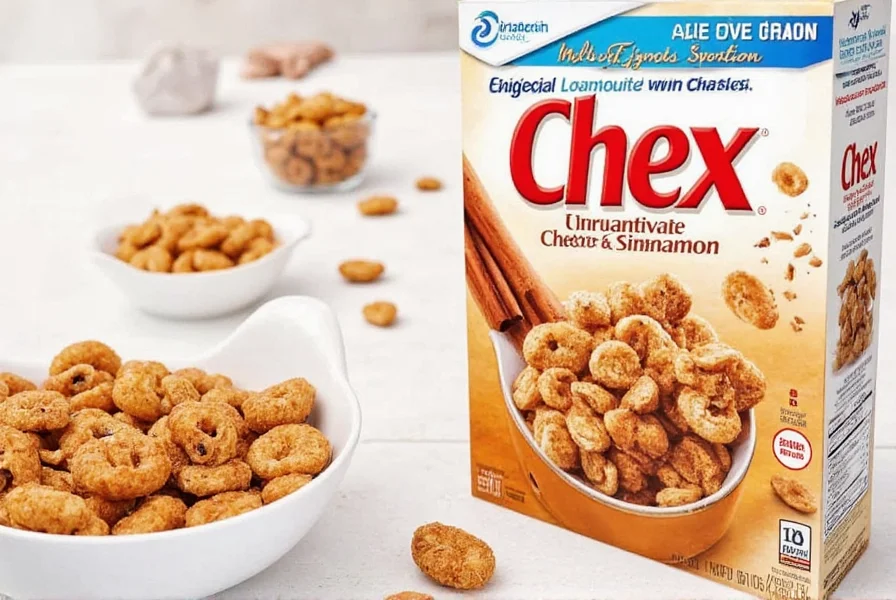For decades, Cinnamon Chex has been a staple in American pantries, offering a subtly spiced alternative to traditional breakfast cereals. This rice-based cereal stands out in the crowded breakfast market with its distinctive cinnamon flavor that's sweet without being overpowering. Unlike many competitors, Cinnamon Chex maintains a light, airy crunch that holds up reasonably well in milk while still providing that satisfying dry cereal experience when eaten straight from the box.
History and Development of Cinnamon Chex
Originally introduced in 1968 as Rice Chex with cinnamon flavoring, Cinnamon Chex established itself as a distinct product line within the Chex family. The cereal was developed during a period when American breakfast preferences were shifting toward more flavorful options beyond plain corn and wheat varieties. General Mills recognized an opportunity to create a cereal that offered the light texture of rice-based cereals with the warm, comforting flavor of cinnamon—a spice with deep roots in American culinary tradition.
Over the years, Cinnamon Chex has maintained remarkable consistency in its recipe while adapting to evolving consumer preferences. The cereal has seen minor formulation changes to reduce sugar content and emphasize whole grains, aligning with broader nutritional trends without compromising its signature taste profile.
Nutritional Profile and Ingredients Analysis
Understanding cinnamon chex cereal nutrition facts is essential for health-conscious consumers. A standard 1 1\/4 cup (39g) serving contains:
| Nutrient | Amount per Serving | % Daily Value |
|---|---|---|
| Calories | 160 | - |
| Total Fat | 1g | 1% |
| Sodium | 240mg | 10% |
| Total Carbohydrate | 35g | 13% |
| Dietary Fiber | 3g | 11% |
| Sugars | 9g | - |
| Protein | 2g | - |
The ingredient list features whole grain rice as the primary component, followed by sugar, salt, and cinnamon. Additional ingredients include molasses, corn syrup, and natural flavor. Notably, Cinnamon Chex is gluten-free certified, making it suitable for those with celiac disease or gluten sensitivity—a significant advantage over many traditional breakfast cereals.

Taste Profile and Sensory Experience
When evaluating what does cinnamon chex taste like, several distinctive characteristics emerge. The cereal delivers a warm cinnamon flavor that's present but not overwhelming—more subtle than many competitors in the flavored cereal market. This balanced approach makes it appealing to both children and adults who prefer less sugary breakfast options.
The texture represents another key differentiator. Each piece maintains structural integrity longer than many puffed rice cereals, providing a satisfying crunch that transitions to a tender bite as it absorbs milk. This textural quality also makes Cinnamon Chex particularly well-suited for snack applications where maintaining crispness matters.
Comparing Cinnamon Chex to Similar Products
When considering cinnamon chex vs rice chex, the primary difference lies in flavoring and nutritional content. While both share the same rice base, Cinnamon Chex contains additional sugar and cinnamon flavoring, resulting in slightly higher calorie and carbohydrate content. The cinnamon variety has 9g of sugar per serving compared to Rice Chex's 2g.
Compared to competing cinnamon-flavored cereals like Cinnamon Toast Crunch, Cinnamon Chex offers a lighter, less sweet alternative with significantly less sugar (9g vs 12g per serving) and more fiber. This nutritional advantage makes it a preferred choice for health-conscious consumers seeking flavorful breakfast options without excessive sugar content.
Creative Uses Beyond Breakfast
One of Cinnamon Chex's most valuable attributes is its versatility. Beyond the traditional breakfast application, consumers have discovered numerous creative ways to enjoy this cereal:
- Cereal snacks: Mixed with nuts and dried fruit for a homemade trail mix
- Baking ingredient: Used as a crunchy topping for fruit crisps and crumbles
- Yogurt parfait layers: Alternating with Greek yogurt and fresh berries
- DIY snack mixes: Combined with pretzels and chocolate chips for a sweet-salty treat
- Cereal crusts: Crushed and used as a coating for baked chicken or fish

Consumer Reception and Market Position
Cinnamon Chex has maintained steady popularity despite shifting breakfast trends. Market research indicates strong consumer loyalty, particularly among health-conscious families seeking flavorful options with moderate sugar content. The cereal's gluten-free certification has expanded its appeal significantly in recent years, capturing market share from traditional wheat-based cereals.
Consumer reviews consistently highlight the cereal's balanced flavor profile—sweet enough to satisfy cravings without the sugar crash associated with many children's cereals. Longtime consumers often mention nostalgic value, recalling childhood memories associated with the distinctive cinnamon taste.
Where to Find Cinnamon Chex and Price Considerations
Cinnamon Chex remains widely available across major grocery chains, warehouse clubs, and online retailers. Standard 12.7-ounce boxes typically retail between $3.50-$4.50, while larger 18-ounce family size boxes range from $4.50-$6.00. The cereal frequently appears in multi-buy promotions, making it a cost-effective breakfast option compared to many premium cereal brands.
For those specifically searching where to buy cinnamon chex near me, the product is commonly found in the cereal aisle of most supermarkets alongside other General Mills brands. Its gluten-free status often earns it placement in specialty dietary sections as well.
Frequently Asked Questions
Is Cinnamon Chex cereal gluten free?
Yes, Cinnamon Chex is certified gluten free by the Gluten-Free Certification Organization (GFCO). General Mills produces this variety in dedicated gluten-free facilities to prevent cross-contamination, making it safe for individuals with celiac disease or gluten sensitivity.
How does Cinnamon Chex compare nutritionally to Honey Nut Cheerios?
Cinnamon Chex contains slightly more fiber (3g vs 2g per serving) and less sugar (9g vs 12g) than Honey Nut Cheerios. Both cereals provide similar calorie counts (160 vs 170 per serving), but Cinnamon Chex offers the advantage of being gluten free while Honey Nut Cheerios contains whole grain oats but is not certified gluten free.
Can Cinnamon Chex be part of a healthy diet?
Yes, Cinnamon Chex can fit into a balanced diet when consumed in appropriate portions. Its whole grain base, moderate sugar content compared to other flavored cereals, and 3g of fiber per serving make it a reasonable breakfast option. For optimal nutrition, pair it with protein sources like milk or yogurt and fresh fruit to create a more complete meal.
Why does Cinnamon Chex taste different from other cinnamon cereals?
Cinnamon Chex has a more subtle cinnamon flavor compared to competitors like Cinnamon Toast Crunch because it uses actual cinnamon rather than artificial cinnamon flavoring. The rice base also creates a lighter flavor profile that doesn't compete with the cinnamon, resulting in a more nuanced taste experience that many consumers describe as "warm" rather than "sweet."
Does Cinnamon Chex contain artificial flavors or colors?
Cinnamon Chex does not contain artificial colors. The ingredient list includes natural flavor but doesn't specify artificial flavors. The distinctive brown color comes from the cinnamon and molasses in the recipe rather than artificial coloring agents, which aligns with growing consumer preference for cleaner ingredient lists.











 浙公网安备
33010002000092号
浙公网安备
33010002000092号 浙B2-20120091-4
浙B2-20120091-4